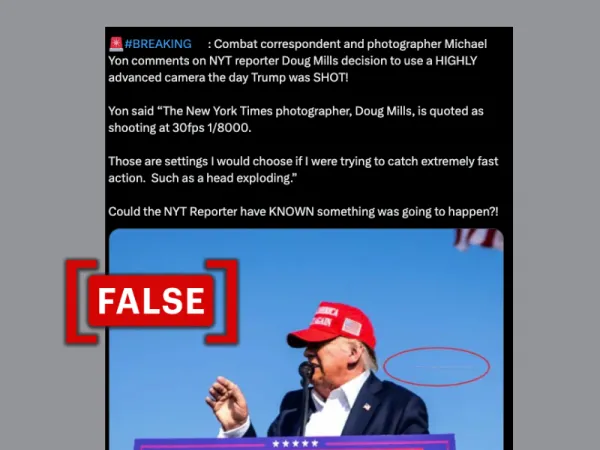By: Anna Aleksandra Sichova
July 19 2024
 Screenshot of the claim that suggests photographer could have had beforehand knowledge of the shooting on July 13 (Source: X/Modified by Logically Facts)
Screenshot of the claim that suggests photographer could have had beforehand knowledge of the shooting on July 13 (Source: X/Modified by Logically Facts)
The photographer's use of unusual camera settings does not imply that he was aware of the assassination attempt beforehand.
The claim
The assassination attempt of former U.S. President Donald Trump on July 13 has sparked numerous speculative claims. One such claim centers on a photograph taken by a New York Times photographer, which allegedly captures a bullet approaching Trump. A user on X (formerly Twitter) speculated that the photographer who took the picture knew about the assassination attempt in advance because of the unusual camera settings. The tweet has garnered 300,000 views and over 5,000 likes.
However, this claim is false. The photographer's use of unusual camera settings does not imply that he knew about the assassination attempt ahead of time.
What we found
Doug Mills is a Pulitzer-winning photojournalist who has covered U.S. politics for over 40 years. His New York Times photo gallery shows that he often documents high-profile political events.
"When the shots came from him, I was probably less than three feet from him, maybe four at the most, because I was right up against the stage, and he was directly above me," Mills recounted about the shooting.
The New York Times posted the metadata from the photo. Mills used a Sony A1 camera capable of capturing up to 30 frames per second with a f/1.6 aperture and 1/8000 shutter speed.
Screenshot of a New York Times Instagram post revealing metadata of the photo of the bullet approaching Trump. (Source: Instagram/Screenshot)
Logically Facts contacted the New York Times to request more details about the photograph has not yet received a response.
Shutter speed is how quickly the camera shutter opens and closes. It's measured in fractions of a second (e.g., 1/500, 1/250). Faster speeds (e.g., 1/1000) freeze action and reduce motion blur, while slower speeds (e.g., 1/30) can create intentional blur to show movement. A shutter speed of 1/8000 is often used in bright lighting conditions or when photographing fast-moving objects, like speeding cars or flying birds.
"Most cameras used to capture images of bullets in flight are using extremely high-speed specialty cameras not normally utilized for regular photography, so catching a bullet on a side trajectory as seen in that photo would be a one-in-a-million shot and nearly impossible to catch even if one knew the bullet was coming," Michael Harrigan, a retired F.B.I. special agent told The New York Times.
Uploading a photo of Donald Trump from the same event, taken by Evan Vucci, the Associated Press's chief photographer, to a metadata analysis website showed that the image was captured with a 1/4000 shutter speed. This fast shutter speed, similar to the 1/8000 used by Mills, is typically used to freeze fast-moving objects in a photo.
Logically Facts consulted Dr. Paul Lowe, an award-winning photographer and Professor of Conflict, Peace and the Image at the University of the Arts London, regarding Mills' camera settings for photographing the rally. Dr. Lowe said, "Although I think the settings he used were unusual, he is a very experienced presidential photographer, so may well have a valid rationale for using them in this scenario based on his previous experience."
A photographer might use these settings during a political rally or protest where sudden actions or movements are expected, not necessarily because they anticipate violence but to be prepared for any significant moment.
The verdict
The claim that New York Times photographer Doug Mills knew about the assassination attempt on Donald Trump in advance because of his camera settings is false. While his camera settings were unusual, they reflect professional judgment, not foreknowledge.